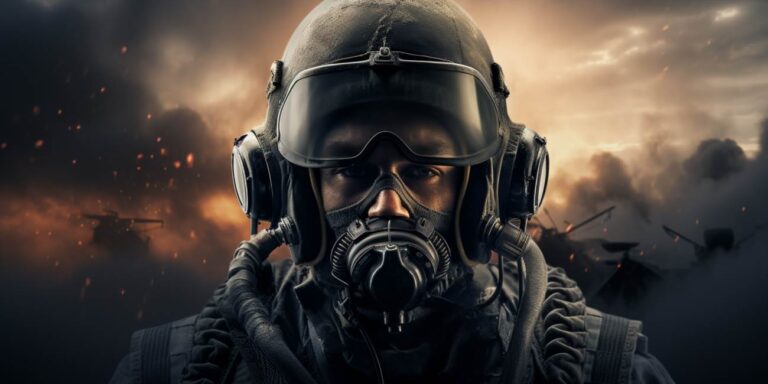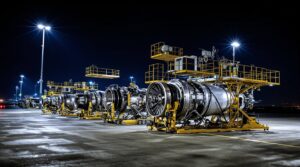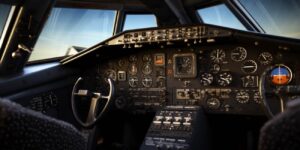So, what is g-force in aircraft? In essence, g-force refers to the gravitational force experienced by an object during acceleration or deceleration. In the context of aviation, it is the force exerted on a pilot due to rapid changes in velocity. This force is typically measured in gravitational units (Gs).
Imagine hurtling through the air at speeds that defy the ordinary. As a fighter jet executes tight turns, climbs, or dives, the pilot becomes intimately acquainted with the effects of g-forces. During sharp maneuvers, the acceleration can be so intense that the pilot feels as if a powerful hand is pressing them into their seat.
Forces in excess of 1 G are part of the everyday life of a pilot. At 1 G, a pilot experiences the normal gravitational force, equivalent to the Earth’s gravitational pull. However, the true intensity of the experience lies in the moments of positive G-forces, where the force is greater than 1, pushing the pilot into their seat with an additional gravitational pull.
Now, let’s delve into the extraordinary realm of negative G-forces. These occur when the aircraft is rapidly decelerating or during inverted flight. Instead of pressing the pilot into their seat, negative G-forces have the opposite effect, pulling the pilot upward. This sensation can be disorienting and physically demanding.
As pilots engage in extreme aerobatic maneuvers, they may encounter high-G conditions, reaching values of 5 Gs or more. At these levels, the human body experiences a force equivalent to five times its own weight. To endure such conditions, pilots undergo rigorous training and wear specialized equipment, including G-suits that inflate to prevent blood from pooling in the lower extremities during high-G situations.
The effects of g-forces extend beyond the physical realm. Pilots must contend with the mental and physiological challenges of sustained acceleration. Vision can narrow, and the exertion required to move becomes significantly more demanding. Understanding and managing these effects are crucial aspects of a pilot’s skill set.
Understanding the impact of heavy g-force on fighter pilots during aerial maneuvers
Fighter pilots, the daring individuals who navigate the skies in high-performance aircraft, experience a unique and intense environment that pushes the limits of both man and machine. Central to their expertise is the ability to withstand and harness the forces of gravity, known as g-forces, during aerial maneuvers.
When engaged in aggressive maneuvers, fighter pilots are subjected to acceleration forces that can be several times the force of gravity. This rapid change in speed and direction puts immense strain on both the aircraft and the pilot’s body. The impact of heavy g-forces is a critical factor in understanding the dynamics of aerial combat.
One of the primary challenges associated with heavy g-forces is the potential for gravitational-induced loss of consciousness (G-LOC). As the pilot maneuvers, blood is forced away from the brain and towards the lower extremities, leading to a temporary loss of consciousness. This phenomenon can occur at g-forces as low as 4 to 6g, highlighting the critical need for anti-g straining maneuvers (AGSM) to counteract the effects.
The human body’s tolerance to g-forces varies among individuals, and training plays a pivotal role in enhancing a pilot’s resistance. Centrifuge training is a common method employed to simulate high g-forces, allowing pilots to develop the necessary techniques to mitigate the risk of G-LOC. This training involves exposing pilots to controlled accelerations, gradually increasing the intensity to build tolerance.
It’s crucial to recognize that the impact of heavy g-forces extends beyond the immediate threat of G-LOC. Prolonged exposure to high g-forces can result in fatigue, both mental and physical, affecting a pilot’s decision-making abilities and overall performance. Additionally, the strain on the cardiovascular system can lead to orthostatic intolerance, making it challenging for pilots to stand or maintain an upright posture post-flight.
The aircraft itself is not immune to the effects of g-forces. Structural integrity is a constant concern, as the forces exerted during maneuvers can subject the airframe to tremendous stress. Engineers employ advanced materials and design principles to ensure that fighter aircraft can withstand the demands of high-performance aerial combat.
Technological advancements have played a crucial role in mitigating the impact of heavy g-forces on both pilots and aircraft. G-suits, worn by pilots, use inflatable bladders to apply pressure to the lower body, helping to prevent blood from pooling in the lower extremities during high-g maneuvers. These suits enhance a pilot’s ability to maintain consciousness and control during intense aerial engagements.
Learning how fighter pilots handle high g-force turns and spins
Fighter pilots undergo rigorous training to handle the intense physical demands of high-g-force maneuvers. One critical aspect of this training involves exposing pilots to extreme gravitational forces in a device called a centrifuge.
The centrifuge is a vital component in preparing pilots for the challenges of rapid and dynamic maneuvers during aerial combat. It simulates the gravitational forces experienced during sharp turns and spins, allowing pilots to acclimate to the intense pressures on their bodies. This training is indispensable for building the physical resilience required to maintain control of the aircraft under extreme conditions.
One of the key elements of the centrifuge training is to familiarize pilots with the effects of high g-forces. These forces can exert significant pressure on the pilot’s body, particularly during sharp turns or evasive maneuvers. Through a carefully designed program, pilots gradually increase their tolerance to these forces, enabling them to withstand and respond effectively in challenging scenarios.
During maneuvers, pilots must employ specific techniques to counteract the forces acting on their bodies. Utilizing proper body positioning and muscle control is crucial for maintaining consciousness and control. The training emphasizes the importance of adopting a strain maneuver, where pilots tighten their abdominal muscles and employ specialized breathing techniques to prevent blood from pooling in the lower parts of the body, ensuring a steady flow to the brain.
These high-g maneuvers demand split-second decision-making and precise execution. Pilots learn a repertoire of aerobatic maneuvers designed to outmaneuver adversaries while minimizing the impact of gravitational forces. These include barrel rolls, Immelmann turns, and the classic aileron roll, each requiring a distinct set of skills to execute flawlessly under the challenging conditions of a dogfight.
The centrifuge training also aids in enhancing spatial awareness and improving cognitive functions under stress. Pilots are exposed to a variety of simulated combat scenarios, forcing them to make rapid decisions while experiencing the strains of high g-forces. This dynamic training environment hones their ability to think critically and react swiftly in the ever-changing dynamics of aerial combat.
Discovering how g-suits help pilots withstand intense g-forces
Pilots, often the unsung heroes of the sky, face a unique set of challenges during high-speed maneuvers and aerial combat. The human body is remarkably resilient, yet when subjected to extreme gravitational forces, it can succumb to the effects of g-forces. These forces exert pressure on the body, particularly when pilots execute rapid turns or sudden changes in altitude.
Enter the ingenious solution – the Anti-G suit. This specialized garment plays a pivotal role in allowing aviators to endure the strains of high-performance flying. The principle behind these suits lies in their ability to counteract the gravitational forces that threaten to compromise a pilot’s well-being.
The mechanism of the Anti-G suit involves inflation, straining, and strategic pressurization. As the aircraft engages in maneuvers, the suit detects changes in gravitational forces and inflates accordingly. The inflated chambers apply straining pressure on the lower part of the body, primarily the legs and abdomen. This deliberate compression helps prevent blood from pooling in the lower extremities, ensuring a continuous flow to the brain.
Without the Anti-G suit, pilots would be susceptible to a phenomenon known as blacking out. When exposed to rapid acceleration, blood tends to rush away from the brain, causing a temporary loss of vision and consciousness. This blackout, albeit brief, can prove catastrophic in a high-stakes aerial environment.
Picture this: A skilled pilot engages in a high-speed dogfight, executing a series of intricate maneuvers to outsmart the opponent. In the absence of an Anti-G suit, the intense gravitational forces would lead to straining the cardiovascular system, pushing it to its limits. The risk of blacking out becomes a real and imminent threat, jeopardizing the success of the mission.
Now, let’s delve into the specifics of how the Anti-G suit functions. The suit features multiple chambers, typically around the legs and abdomen, connected to a pneumatic system. This system detects changes in gravitational forces and triggers the inflation of the corresponding chambers. The straining pressure applied by the inflated chambers counteracts the forces trying to pull blood away from the brain.
Consider the ingenious engineering behind this life-saving garment. As the pilot executes high-G maneuvers, the Anti-G suit responds in real-time, maintaining a delicate balance between pressure and relief. The pilot, cocooned in this technological marvel, experiences a controlled application of force that prevents the onset of blacking out.
In a way, the Anti-G suit serves as a guardian angel for pilots, allowing them to push the boundaries of aerial performance without succumbing to the perilous effects of g-forces. This technology showcases the fusion of human skill and innovation, where the limitations of the body are overcome by the brilliance of engineering.
As we navigate the skies, it’s worth acknowledging the silent heroes beneath the cockpit, where the Anti-G suit stands as a testament to human ingenuity in the quest for mastery over the heavens.






